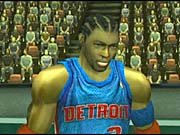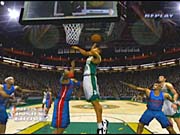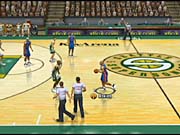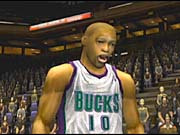Last year's NBA Inside Drive was a decent first entry into the realm of professional basketball for the Xbox, having most fundamentals of the sport intact. But Inside Drive 2002 had some gameplay problems and a serious lack of secondary options to choose from, which limited the game's appeal among die-hard basketball fans. Inside Drive 2003 fixes many of its predecessor's problems and takes a major step forward in becoming a serious contender, with an all-new franchise mode and some notable gameplay tweaks. But there are still some lingering issues that keep this one from being the best basketball game for your money.

The biggest addition to this year's iteration of Inside Drive is the franchise mode, a feature sorely lacking in last year's game. Like in most other franchise modes, you can select a team and take it through multiple NBA seasons (in this case up to 25 seasons) in an attempt to make it to the championship. After selecting a team in this mode, you can adjust a number of options, including whether or not you want to participate in a fantasy draft, the difficulty level, the length of the season, player streaks (whether a player can become "hot" or "cold" depending on performance), fatigue, and other similar options. In addition, you can make some last-minute tweaks to your team before starting the season by entering the front-office option. In this area, you can edit the current roster, trade players, sign free agents, release current players under contract, create a player, or get an overall view of your team's accolades.
The trading system in Inside Drive's franchise mode is pretty straightforward. You can put any three players for your team up for trade and so can the opposing team, so it's possible to have a full three-man exchange where both teams get three new players, or you can have a three-for-one or two-for-one trade where one team tries to get a star player for two or three lesser players, though the chances of the latter trade strategy being successful are apparently slim. It's also worth noting that you can trade players for draft picks, but the same rules apply--you won't have much success in trading a second-tier player for a team's first-round draft pick. When you're done adjusting the team roster, you can move into the season and go for the NBA championship.

Your record at the end of the season--or in some cases your front-office dealings--will determine your position in the NBA draft, so if you finish with the worst record, then you'll have a much better chance of securing the number one pick. When it's your time to make a selection in the draft, you'll be presented with a list of players as well as their individual statistics, such as overall performance. Moreover, you'll see the predicted draft choice for the team, so you'll get an idea of what sort of player you need to choose if you haven't been paying attention to your team's weaknesses or strengths. Of course, the draft isn't the only way to secure new talent or to fill holes left by retiring players in Inside Drive's off-season. You can also scour the free-agency ranks for any potential new players, but you also need to be aware of your current "financial" position since a big-name free agent can potentially put you over the point cap in the game.
Along with the franchise mode, Inside Drive offers a new practice mode where you can familiarize yourself with the basics of the game, particularly shooting, which feels a little odd initially simply because you don't really get a good feel for when a player reaches the top of his jump. This results in the timing of your shots being a little off, ultimately leading to a missed basket in most cases, but a few runs through the practice mode should get you to the point where it's not quite as awkward.
There are also single-game and playoff options for those who either want to jump right into a game or skip the entire season and go directly for the NBA Championship. The create-a-player mode, which was missing from Inside Drive 2002, is fairly robust, allowing you to change just about every aspect of the player's physical appearance, offensive capabilities, defensive capabilities, shooting skills, and AI tendencies, which function similarly to the gameplay sliders.

As far as actual gameplay is concerned, Inside Drive is solid on almost every front except for some aspects of the offensive game, the most notable problem being the inability to pass out of layups or similar moves to the basket. One of the most important aspects of professional basketball is being able to drive to the lane and have a player make it look like he's going up for a shot so that he can draw defense, but then pass the ball to an open man on the inside or to a wide-open player out on the perimeter. Indeed, generally driving through the lane can be a little problematic since the AI tends to latch onto players in the paint, and the juke moves can be difficult to use effectively against tough opponents.
Conversely, the post-up game is executed quite well. When a ball goes down to a man on the block, he can post up the defensive player and drive to the basket for a closer jump shot, or the man with the ball can roll off the defender and try to go in for the dunk or layup. You can also use this opportunity to draw a double team from the defense and then pass the ball out to a teammate on the outside. The defensive side of the ball is pretty well balanced, and you shouldn't have too much trouble staying on the ball handler, unless it's a star player like Shaquille O'Neal or Kobe Bryant, who seem to have an unnatural ability to score consistently from just about any area on the court.
Inside Drive 2003 doesn't look substantially different from last year's game, but the players still look quite detailed, even if they're not entirely accurate. The arenas look good as well, but the crowd--which animates poorly, and simply looks like an enormous cardboard cutout--is in dire need of some work, though there are some nicely detailed player models on the player benches. It's also worth noting that the game lacks any sort of TV-style presentation. At the end of a game, players inexplicably stand at the side of the court like zombies while the commentators give their final thoughts on the game, and the player introductions are lacking in fanfare.

The commentary is surprisingly great and comes very close to matching the excellent commentary in the NBA 2K series. The team is made up of four people, most notably Kevin Calabro and Kenny Smith, and each of them brings a unique style of insight to the game. More importantly, almost all the commentary seems to flow well, and the commentators will even interact with each other, making it seem much more natural.
The extra options, especially the franchise mode, succeed in giving Inside Drive 2003 the longevity that Inside Drive 2002 lacked, and the refinements to the gameplay make it more entertaining. The commentary is also vastly improved and worth paying attention to as a game progresses. However, Inside Drive still lacks some of the finer details of the sport as well as some features that are being offered by the competition, most notably online play. In any case, Inside Drive 2003 is still a solid improvement over last year's game.